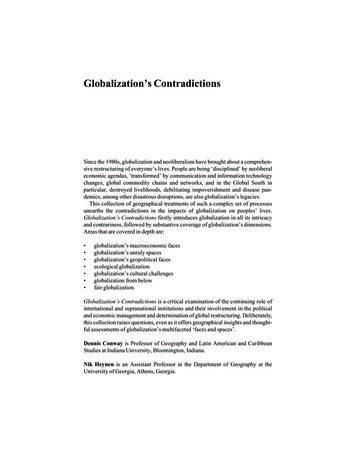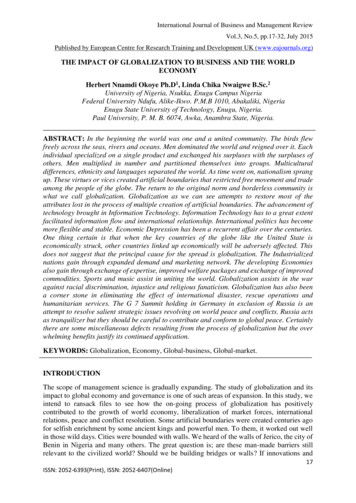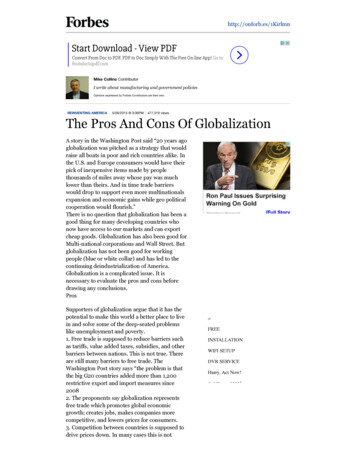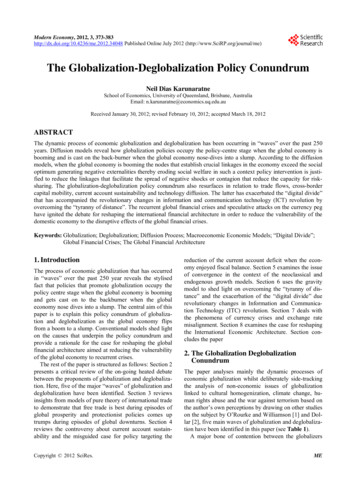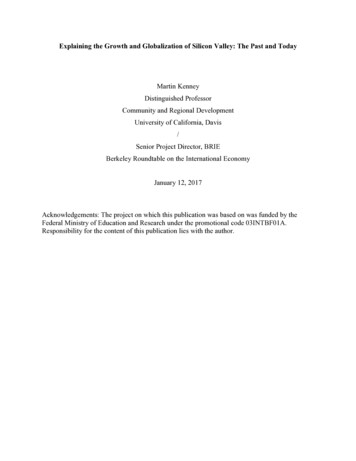
Transcription
Explaining the Growth and Globalization of Silicon Valley: The Past and TodayMartin KenneyDistinguished ProfessorCommunity and Regional DevelopmentUniversity of California, Davis/Senior Project Director, BRIEBerkeley Roundtable on the International EconomyJanuary 12, 2017Acknowledgements: The project on which this publication was based on was funded by theFederal Ministry of Education and Research under the promotional code 03INTBF01A.Responsibility for the content of this publication lies with the author.
IntroductionThe San Francisco Bay Area encompassing Silicon Valley is arguably the most importantregion in the world for the application of digital technologies to social and economic life. MartinKenney and John Zysman (2016) have argued that a new economy based on digital platforms isemerging and Bay Area firms are at the center of this development. The current conjuncture isthe result of a set of historical forces, some of which are very local and others of which areglobal and national. The region is the result of an intensely local process even as its firms,entrepreneurs and markets are global. Silicon Valley’s rise to prominence, since, at least, theearly 1980s, has had an increasingly significant effect upon the global political economy throughits gradual emergence as the center of the world’s information and communication technologies(ICT).In the 1990s Silicon Valley achieved iconic status for economic development plannersglobally. But how did the particular constellation of public goods, private sector actors,concentration of human skills, and even a particular ideology come into being? This paper arguesthat the rise of Silicon Valley was a social process of emergence in which a number of social andtechnical forces combined to create the region. As new actors emerged, they created solutions forvarious problems that they confronted and, as they met with success and gained strength, theyparticipated in the transformation of existing regional institutions such as the local universities.For the most part, these were responses to immediate problems or path-dependent drifts, ratherthan wisely considered, far-sighted solutions by prescient economic actors maximizing theirutility functions. Like the Panda’s thumb, solutions that “worked” were diffused, repeated, andadjusted, gradually evolving into routines and institutions (Nelson and Winter 1982).When discussing a region that derives its dynamism from new firms commercializingnew technologies, it seems proper that the technology (ies) and its (their) trajectory (ies) should1
be examined (Dosi 1984). The technologies, socially constructed and shaped, are the rawmaterial that entrepreneurs utilize to create their firms. The information and computertechnologies (ICT) are the technical bases for the region. Thus, on one dimension,understanding Silicon Valley is predicated upon tracing the evolution of technologies and theindustries based on them, and, on the other dimension, the evolution of the institutions, practices,and cultural understandings that orient action.Schumpeter recognized that technological change offers possibilities to entrepreneurs, butestablishing a new firm is difficult and risky. During the past five decades in regions like SiliconValley, a support infrastructure of institutions that assist in new firm creation has evolved tomitigate the liabilities of newness (Stinchcombe 1965). In Silicon Valley, successfulentrepreneurship preceded the creation of the institutions such as venture capital (Feldman 2001;Kenney 2000) and after these support organizations came into existence they incited furtherentrepreneurship by creating demand for startups.They also lowered entry barriers bysimplifying the firm formation process, and speeding the growth of startups. Through theprovision of capital, services, and advice, they increase the probability of new firm formationand speed new firms’ growth.1 Gradually, the institutions providing such assistance became partof the environment, thereby altering the trajectory of further evolution. The institutions and theagents within Silicon Valley have survived repeated downturns that have winnowed participantsand business models.1There is considerable debate as to whether location in the cluster increases survival rates.2
I. Short History of Silicon ValleyThe genesis of Silicon Valley (SV) is difficult to date exactly, as already before WorldWar Two there were electronics firms including a fledgling Hewlett Packard operating in theregion (Sturgeon 2000). However, the semiconductor industry from which Silicon Valley drawsits name can be considered to have begun in 1956 when William Shockley, one of the inventorsof the semiconductor at Bell Laboratories, established Shockley Semiconductor in Santa Clara,California. At this early date, there was no reason to believe that the semiconductor industrywould concentrate in the San Francisco Bay Area – there were an ample number of other regionswith sufficient technical expertise for the early industry. Shockley proved to be an incompetentmanager, and in 1958 eight of his best scientists left to form a new firm, FairchildSemiconductor. Fairchild was funded by an East Coast industrialist, Sherman Fairchild. FairchildSemiconductor’s earliest customers were federal agencies such as the Department of Defenseand NASA. As important as it was technologically, more important was that engineers andmanagers, almost immediately began leaving Fairchild to form new startups (Lecuyer 2006). Theproliferation of semiconductor startups led the editor of Electronic News in 1973 to describe theregion as “Silicon Valley” – a moniker that continues to be used to this day.Of course, the region was not a tabula rasa. Frederick Terman, the former Dean ofEngineering and Stanford Provost, encouraged Shockley to establish his firm in Palo Alto.Terman was actively encouraging the growth of a local electronics industry in the region. ManyEast Coast firms established branch R&D operations in the region and in 1952 IBM decided toestablish a branch of its Yorktown Heights research laboratory in San Jose to tap the skilledpersonnel in the area. Even as Terman was encouraging the development of a regional electronicindustry, he was also aggressively building Stanford’s research capability through securing3
military funding for research (Leslie and Kargon 1996). At its root, as we shall see, the successof the cluster in the region is the result of the strategies of key actors, happenstance, andinstitutional evolution.II. TechnologyTechnology cannot determine social or economic activity. And yet, as both Marx andSchumpeter recognized, it creates opportunities for entrepreneurial activity. To paraphrase Marx,it is an important force for dissolving barriers to entry to old economic activities and facilitatingthe creation of entirely new industries – or to put it in the contemporary vernacular, “disrupt”previous businesses.The fundamental disruptive technology developed in Silicon Valley is, of course, thesemiconductor, which has for the last 50 years had a relatively constant improvement trajectoryof roughly doubling the processing power for the same price every 18-24 months (see Figure 1for a visualization of this process). This increasing ability to process data is so important becausedigital problems that were too difficult to solve in one-time period become amenable to solutionlater as processing power increases. For example, transforming analog sounds into digitalrepresentations and back to the sound we hear is/was computation intensive and essentiallyimpossible in 1960 as the processing power was not available. It might be possible to writealgorithms that could do this theoretically, but practically it was impossible. However, thecontinuing improvement in semiconductors (and laser systems) would make this possible by thelate 1970s and eventually make the compact disk player trivially inexpensive. This example onlyillustrates the point that what, at one time was impossible, later became possible, and then trivial.Figure One about here4
While the semiconductor is the fundamental technology, the development of themicroprocessor proved to be particularly important. The microprocessor was essentially acomputer capable of processing information that resides on a single chip – and it alsoexperienced the same improvement dynamics as did other semiconductor devices. Firms indifferent regions developed microprocessors, but it was in Silicon Valley in the late 1960s thatIntel emerged from Fairchild and even more importantly, yet other people, particularly hackerssuch as Steve Jobs, Steve Wozniak, Adam Osborne, Lee Felsenstein and others, began cobblingtogether small microcomputers (Freiberger and Swaine 1984) based on the newly introducedmicroprocessors.Remarkably, nearly simultaneously with the semiconductor, magnetic data storage alsobegan a remarkable technological improvement trajectory, driven in large part by technologicaldevelopments occurring in the IBM laboratory (and production facility) located in the San Josearea.2 Very soon other technologies would emerge. At the hardware level, there was theemergence of networking equipment as engineers wanted to connect these smaller computerstogether and to main frames. This included local area and wide area networks. Again, SV wouldtake the lead in this area. Finally, on top of all the physical infrastructure artifacts was softwaredevelopment that would allow SV over time to transition from being centered upon physicalcomputation and objects, such semiconductors and network infrastructure equipment, to softwareand then the Internet, and today social media. As the software “detached” from the hardware,remarkable new business opportunities emerged due to what Zysman (2006) terms the“algorithmic revolution.”5
Semiconductors and Ancillary IndustriesSemiconductor technology was so fecund in opening new economic spaces that newbusiness opportunities repeatedly emerged, and the cognoscenti had opportunities to create theirown firms. This fecundity is illustrated by the fact that Fairchild and its successor firmsexperienced 134 spin-offs by 1986 (SEMI 1986), and there have been more since then; almostalways founded by someone that could trace their employment experience back to a firm thatdescended from Fairchild. The doubling of processing power was accompanied by anotherdynamic, namely the ever increasing cost of a fabrication facility (Leachman and Leachman2004). When Fairchild began producing chips, converted pizza ovens were used for the bakingprocess. By 1975, a fabrication facility cost approximately 50 million (OhUuallachain 1997:220), while in 2016 the cost of an Intel state-of-the-art fab is 8.5 billion (Chafkin and King2016). As the costs of fabrication increased, it was no longer possible for startups to establish afirm and manufacture their chips, so new startups began contracting out to firms that specializedin manufacturing chips – by the end of the 1980s, these contract fabs were offshore in Taiwan.Silicon Valley firms now only designed and marketed the ICs. At roughly the same time ICsbecame so complex that hand designing was no long possible and engineers began developingdesign software. The UC Berkeley electrical engineering and computer science department,funded by the Department of Defense and NSF did much of the early research. They created anopen source design software program that was commercialized by students and professors (seeFigure 2 to illustrate this relationship). This software was critical for the relationship betweenSV designers and offshore contract fabrication operations as the data could be directlytransmitted to the contract fabrication facility.2For a discussion of the relationship between the IBM Laboratory and the electrical engineering department at UC6
Figure Two about hereSV became not only the center of the semiconductor industry, but the center of thesemiconductor equipment and software industries as well. Through an intensive interaction withthe local industry, UC Berkeley and Stanford became elite electrical engineering and computerscience research centers. While significant design and headquarters functions remain in theregion, no semiconductor fabrication remains. The semiconductor industry was important forreasons beyond its technological centrality. First, the culture of spinoffs and raising venturecapital was cultivated in semiconductors, but soon spread to other ICT industries. Second, thesemiconductor industry provided significant investment opportunities for venture capital. Third,the industry attracted attention to the region and some of the IC industry entrepreneurs such asRobert Noyce, Gordon Moore, and Jerry Sanders achieved fame and became models for otherentrepreneurs. Fourth, proximity to the semiconductor industry allowed venture capitalists andentrepreneurs in other industries to glimpse the future, or, as the futurist, William Gibson, oncesaid, “the future is already here — it's just not very evenly distributed.” The semiconductor’sprogress trajectory meant the future was often there in SV before being in other places.ComputersThe true breakthrough in terms of computers came when the microprocessor madepossible the creation of desktop computers, both personal computers and work stations. Two SVuniversity spinoffs, Sun Microsystems and Silicon Graphics, became enormously successfulwork station firms. While successful in developing work stations, with the exception of AppleComputers, the other Silicon Valley micro-computer firms soon failed when IBM introduced theBerkeley, see Kenney et al. 2014.7
personal computer. However, SV, with its entrepreneurial ethos, came to be the home ofnumerous startups that would supply components including microprocessors (Intel and AMD),BIOS chips (AMI, Phoenix Technologies, and Chips and Technologies), graphics chips (S3,Nvidia, and Cirrus Logic), hard disk drives (Seagate, Quantum, and Conner Peripherals), printers(Daisy Systems), and even computer mice (Logitech and Kensington) to PC assemblers that werenot located in the region. In PC software, Microsoft soon became dominant and, by 1990, itappeared to many that SV might no longer be the future of the ICT industry. However, with thedesktop computer came the desire to link computers to one another, i.e., to network them.Computer Networking Equipment3Much of the impetus for connecting separate computers together came from theDepartment of Defense (Abbate 1999). Heavily supported by DARPA, time-sharing ofcomputer capacity was one of the earliest forms of computer networking (a wide area network),and a number of startups were established in Silicon Valley and other regions to exploit it. In1969, DARPA launched the Arpanet (the precursor to today’s Internet). Also, with the adoptionof the minicomputer, departments and divisions in corporations and on campuses also installedcomputers and there was increasing interest in linking them together locally (LANs) and the dialup connections used for WANs seemed unnecessary and inefficient. Thus, simultaneously therewas demand for WANs and LANs.One proximate cause for dramatically increased interest in computer networking was aneffort that began in the early 1970s to automate the office. This “office of the future” required anetwork to share files between computers and expensive peripherals such as printers and data3This section is largely drawn from von Burg (2001).8
storage devices. A pioneer in this quest was Palo Alto-based Xerox PARC, which in the mid1970s created a system of small computers, laser printers, and data storage devices networked bywhat would be called “Ethernet.” PARC was not alone in this effort; minicomputer firms suchas Boston-based Wang Computers were also experimenting with the dedicated office automationcomputers.In the early 1980s, desktop computers were proliferating and entrepreneurs beganforming firms to network these computers and the most successful of these were located inSilicon Valley (von Burg 2001). The proliferation of networks running different protocols,created an opportunity for an interconnection solution. The most successful communicationsinterconnection firm would be Cisco Systems, a Stanford University spin-off that introduced amultiprotocol router. With the volume of data being communicated rising exponentially, therewas a proliferation of opportunities to establish new firms with better data communicationstechnologies (essentially data handling computers) and there were waves of new entrants startedby engineers in existing firms and funded by venture capitalists. In fact, the incumbentnetworking firms, and especially Cisco, developed a strategy of acquiring the fledgling startups,but at enormous multiples making investors and the firm founders extremely wealthy (Mayer andKenney 2004). Not surprisingly this encouraged a further proliferation of networking startups.The key to these new firms was not the equipment they built, but rather the software thatthey developed to handle the data – production would be outsourced to specialized assemblyfirms. While SV was not initially a center for optical fiber technology development, during the1990s optical components for data transmission also grew remarkably due to venture capitalfinanced technology development. Even more important, as the network became morecomplicated, it provided yet more entrepreneurial opportunities for network management,9
security, and other software and hardware such as specialized ICs (designed with thesemiconductor design software described earlier). By the mid-1990s computer networking hadbecome one of the core Silicon Valley industries. With the increasing dominance of digitalnetworking technology, nearly all the incumbent telecommunications networking firms (Alcatel,Fujitsu, Lucent, NEC, Siemens Networking, and Northern Telecom) would be destroyed ordramatically weakened.4SoftwareThe creation of a freestanding software industry is often traced to the IBM-USgovernment consent decree in which IBM agreed to unbundle its hardware and software. Thisdecision meant that innovators could develop products that would operate with the IBMproducts, which at the time dominated the entire market. Even, as IBM was unbundling,minicomputers that allowed independent third-party software vendors to write programs for themwere introduced. The importance of software, of course, is that it directs the computationalpower to produce a desired outcome, i.e., what the user wants. Over time, the entrepreneurship inSilicon Valley would become software-centric, as can be seen both in terms of employment andventure capital investment (see Figures 3 and 4) and, in fact, the SV hardware firms alsobecame increasingly software-centric as the value in their products increasingly was based on thesoftware. The growth in the importance of software occurs in approximately 1980, roughlycoinciding with the introduction of desktop computers, which were more modular and open, asboth the Microsoft and Apple operating systems operated as platforms with interfaces so that4The most successful of these firms, Ericsson and Nokia, survived based upon their strengths in wirelesscommunications. The threat to these networking equipment firms and, in particular, Cisco would come from theChinese networking equipment maker, Huawei.10
software from third-party vendors could operate on them. Further, the proliferation of desktopcomputers would create an ever larger market for software programs.Figure 3 about hereThe change can also be seen in venture capital investment. Importantly, during this entireperiod SV received between 30-40% of all investment in the United States. The unusually largespike in the “Other” category in the Dot.com Bubble was driven by media and entertainmentinvestments. 5 What is most important is that during both the Dot.com Bubble and the recentperiod VC investment in software expanded immensely.Figure 4 about hereIn software, as has been the case with other industries, Silicon Valley has pioneeredvarious software sectors; some of which would be extremely important for the transition of theregion to one that is software-centric. Microsoft’s PC software monopoly resulted in the demiseof Silicon Valley firms such as VisiCalc and Borland Computer. Even when new PC softwaresuch as the Netscape browser was commercialized in Silicon Valley, Microsoft used itsmonopoly power to destroy them. Two of the most important SV survivors of this onslaughtwere Adobe Systems and the tax software producer, Intuit.Silicon Valley firms have been far more successful in business productivity software.The most significant of these was relational database software, which was pioneered roughlycontemporaneously at IBM’s San Jose Laboratories and UC Berkeley. All of the keyindependent relational database firms (with the exception of Microsoft, a late entrant) are located5Included in the other category in order of importance Media and Entertainment, , Industrial/Energy, Telecommunications, and Computers and Peripherals.11
in Silicon Valley. The largest of these is Oracle which, after Microsoft, is the second largestindependent software firm in the world. Other important firms include Sybase, Informix(purchased by IBM), and IBM. Oracle, in particular, spawned other important business softwarefirms including PeopleSoft and Seibel, which pioneered other niches in business software., Silicon Valley also experienced success in entertainment software. Here, the SiliconValley pioneer was Atari, which later collapsed. Atari’s demise in the 1970s permitted thecontrol over the game boxes to move to Japan, and today Japan is the major competitor for theU.S. game software makers. The largest entertainment software firm in Silicon Valley isElectronic Arts, which used to be a developer and today not only produces games but alsodistributes them for other producers. These game software firms are intimately connected to thecutting-edge PC graphics chipmakers also located in the region.Though Silicon Valley did not prove to be as dominant in software as in some otherindustries, it did become one of the key global software centers. The remaining software firms inthe region have integrated Indian software production capabilities into their global footprint, inthe same way, as the semiconductor design firms integrated Taiwanese fabs. In the PC era, thelocus of the consumer software industry was, of course, Microsoft.The Worldwide Web – Silicon Valley Becomes the CenterThe Internet was a national defense project, but the real key to commercialization was theintroduction of the WWW protocols that were developed in 1991–92 at CERN in Geneva(Abbate 1999; Kenney 2003). In 1993 entrepreneurs had not yet comprehended theopportunities that the Internet represented and there was also a delay in convincing venturecapitalists that the WWW presented an investment opportunity (Ferguson 1999). However, the12
lag in comprehension did not last long, especially in Silicon Valley, and by early 1994 venturecapitalists were receiving business plans from entrepreneurs with ideas for the commercialexploitation of the WWW. The first easy-to-use web browser Mosaic formed the basis of one ofthe earliest Internet startups, Netscape, which was established in April 1994 by Marc Andreesen,a recent University of Illinois, and Jim Clark, an ex-Stanford professor and founder of SiliconGraphics Inc. Less than one and one-half years later, Netscape had an initial stock offering inAugust 1995 at a valuation of nearly 1 billion. Netscape’s remarkable increase in value alertedevery venture capitalist and entrepreneur that the WWW was a new opportunity. Given thegreater venture capital resources and large numbers of entrepreneurs, the Bay Area quicklybecame the center for WWW startups (Kenney 2003; Zook 2002).As the number of WWW users exploded, new business ideas and opportunitiesproliferated. This expansion provided opportunities for yet other startups to develop newsoftware and Web-based services. Businesses were built around searching and cataloging othersites (Yahoo!, Excite), selling products online (eBay and Amazon), software tools, building newcommunications networks (Exodus) and Web-hosting services among many others. Investorswere willing to fund entrepreneurs experimenting with an amazing proliferation of businessmodels. By mid-1999 there was a full-scale investment panic as public investors drove stockprices skyward. By the time the Bubble ended in 2000, more than 370 self-identified Internetrelated firms had gone public and their total valuation had reached 1.5 trillion, though they hadonly 40 billion in sales (Perkins 2000). The returns for the most successful VC funds wereastronomical—many had annual returns of 100 percent and one even had a 400 percentannualized return. The amount of venture capital invested in Internet-related firms grew from anearly negligible 12 million in the first quarter of 1995 to 31 billion in 1999 (NVCA 2000).13
Approximately, 50 percent of all the new Internet firms were headquartered in the Bay Area.Faster than anywhere else, Silicon Valley entrepreneurs glimpsed the potential of the WWW as acommercial opportunity and then mobilized the resources necessary to try to realize that future.The dot.com bubble, as Figure Four also shows, was the largest VC bubble in SVhistory. This was driven by a torrid IPO market, where it was possible to raise enormous amountof capital for new firms with extremely weak business models. A prime example of this is the 1.2 billion in capital lost on Webvan, a firm established in 1996, had an IPO in November 1999,and collapsed in 2001 (Aspray et al. 2013). In the case of Webvan, two factors contributed to itscollapse. The first was a business model that was so uneconomical that the firm could notsurvive even with an enormous capital endowment. The second was the collapse of the stockmarket that meant it was unable to raise even more capital. However, another firm with a moneylosing business model, Amazon.com, was able to continue to raise capital despite making verylittle money. The ability to raise capital while continuing to lose money is vital when expandingand competing against incumbents that must make a profit. The incumbents can be driven fromthe market by an inferior business model (i.e., one that does not make a profit). Whencompetitors, such as bookstores in the Amazon case, are driven from the market a monopoly canbe the outcome. This capture of the node in a value chain also means that other nodes becomevulnerable. In the case of Amazon, the next node in the value chain it threatened were publishers(for this struggle, see Gessen 2014), as Amazon began encouraging self-publishing.In 2000, the Bubble collapsed and hundreds of startups went bankrupt. Though, what isimportant to remember is that many of them survived and, as important, a new set of skillsrelated to managing data centers, big data, and a fledgling cloud computing capability emerged.14
This would become vitally important in the next wave of SV firms that would form what Kenneyand Zysman (2016) have termed a “Platform Economy.”Social Media and the Platform EconomyAfter the collapse of the dot.com bubble in 2000 funding for new firms droppeddramatically, but there were exceptions to the relatively negative environment. For example,Google established in 1998 went public in 2004. During this relatively depressed period, firmssuch as Facebook, Instagram, LinkedIn, Pinterest, Twitter, and YouTube were formed based onproviding a “platform” on which users could communicate. These firms were built uponmonetizing user-generated content.For Silicon Valley, yet again, there would be a dramatic technical change, with theintroduction and rapid adoption of the smartphone. This would mark a profound shift in theglobal ICT industry, as the two dominant operating systems, Apple’s iOS and Google’s Android,belonged to SV. These two operating systems would begin a displacement of Microsoft and thepersonal computer as the core computing device. It would be SV firms that would drive themovement of the heavy-duty computing to the cloud (though, of course, Amazon and Microsoftremain powerful firms). New transformative firms such as Uber/Lyft and Airbnb are predicatedupon the functionality of the smartphone.6There also was an ideological shift, which was already inherent in the SV culture, but hasbecome dominant recently – namely the philosophy of “doing something first, and askingregulators forgiveness later.” This has combined with a technophilia, libertarian philosophy, andan emphasis on disrupting existing industries and arrangements by whatever means possible.15
Fueled by an enormous influx of finance capital, a global-class technical work force, a number ofthe global ICT pace-setting firms, and benign neglect upon the part of regulators, SV appearsmore central and successful than ever. Of course, it is possible that SV is, once again, in one ofits periodic bubbles. At this time, the only country that has remained largely immune to thestrength of SV’s platform firms is China (see Jia and Kenney 2016).III. Entrepreneurial Support Networks and CultureCluster studies have shown that successful regions develop an infrastructure includingpublic goods, rich supplies of specialized labor and input providers, strong local competitors, andindustry-specific information (Porter 1998). What most observers do not fully appreciate is thatthe product of SV is new firms that embody a perceived new technology/business opportunity(TBO). The adjective “perceived” is vitally important because a priori no one can judge whetherthe TBO will be successful. For all involved, “success” is defined as the ability to sell the firmformed to exploit the TBO for a significant m
Silicon Valley's rise to prominence, since, at least, the early 1980s, has had an increasingly significant effect upon the global political economy through its gradual emergence as the center of the world's information and communication technologies (ICT). In the 1990s Silicon Valley achieved iconic status for economic development planners


